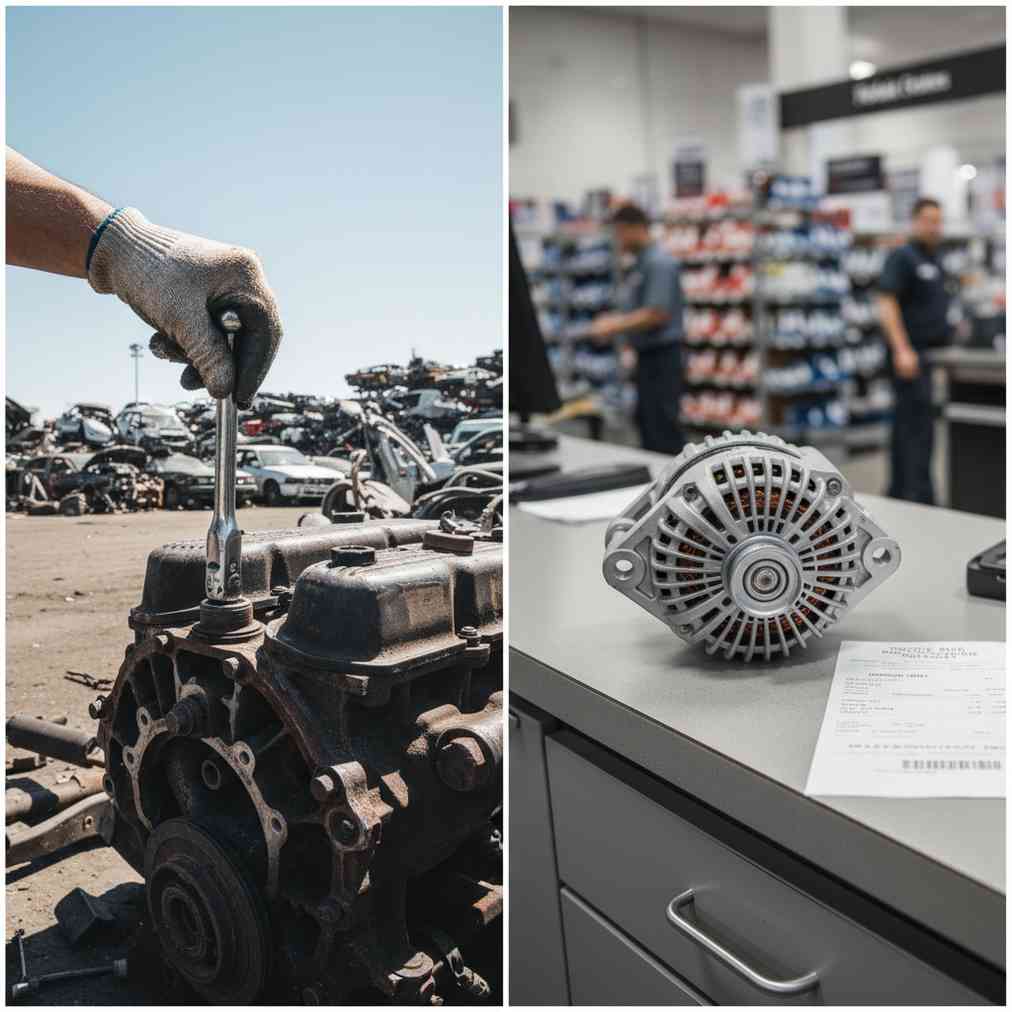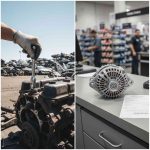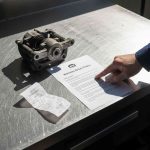Understanding the Two Main Types of Salvage Yards
When you’re searching for affordable auto parts, not all salvage yards operate the same way. Understanding the difference between full-service salvage yards and self-service yards (commonly known as “U-Pull-It” or “Pick-and-Pull”) is crucial for making the right choice for your specific needs, budget, and mechanical skills.
The choice between these two types of salvage yards near you depends heavily on several factors: your mechanical expertise, available time, budget constraints, and the specific part you need. Each model offers distinct advantages and challenges that can significantly impact your parts-buying experience.
Self-Service Yards: The DIY Approach to Auto Parts
In a self-service salvage yard, customers take full responsibility for locating the correct vehicle, bringing their own tools, and safely removing the desired parts themselves. This hands-on approach has transformed the auto recycling industry by making quality parts accessible to budget-conscious consumers.
Advantages of Self-Service Yards
| Benefit | Details |
|---|---|
| Significantly Lower Prices | Parts cost 50-80% less than new because you provide the labor. Pricing is often standardized by part type rather than vehicle model. |
| Wide Vehicle Selection | Often maintain broader inventories of older, rare, or less common vehicles that full-service yards might not stock. |
| Immediate Availability | Walk in, find your part, and leave the same day without waiting for staff to locate and remove parts. |
| Learning Opportunity | Perfect for DIY mechanics who want hands-on experience understanding how vehicles are assembled. |
Challenges of Self-Service Yards
- Tool and Skill Requirements: You must bring a complete tool set and possess the mechanical knowledge to remove parts without damage
- Time Investment: Searching the entire yard and performing the removal work requires significant time commitment
- Safety Concerns: Navigating unstable vehicles and working in potentially hazardous conditions
- Unknown Part Quality: Parts are typically not tested, cleaned, or inspected before sale
- Limited Warranty Protection: Shorter warranty periods compared to full-service alternatives
Popular self-service chains like Pull-A-Part and LKQ Pick Your Part have revolutionized this model by offering organized inventories and standardized pricing across multiple locations.
Full-Service Salvage Yards: Professional Parts Solutions
A full-service salvage yard handles the entire process from start to finish. Professional staff locates parts, safely removes them using proper equipment, cleans and tests them, and prepares them for sale with appropriate quality assurance measures.
Benefits of Full-Service Operations
| Advantage | Value Proposition |
|---|---|
| Complete Convenience | Professional staff handles all labor, from location to removal to preparation |
| Quality Assurance | Parts are carefully removed, cleaned, tested, and sometimes refurbished before sale |
| Online Inventory Systems | Check availability online before visiting, often with same-day service or delivery options |
| Comprehensive Warranties | Robust warranty coverage, sometimes including labor warranty options |
| Enhanced Safety | Eliminates customer safety risks associated with yard navigation and part removal |
Drawbacks of Full-Service Yards
- Higher Costs: Parts are significantly more expensive due to labor, testing, and refurbishment costs
- Limited Selection: Many specialize in specific vehicle types or newer models, reducing variety
- Small Parts Economics: Low-value items like clips or trim pieces may be cost-prohibitive to stock
- Dependency on Staff: Availability depends on staff schedules and workload capacity
According to recent industry data analysis, full-service yards are becoming increasingly sophisticated in their inventory management and quality control processes.
Industry Trends and Market Evolution
The salvage yard industry is experiencing significant transformation driven by multiple factors:
- Rising Scrap Metal Demand: Increased global demand for recycled metals affects yard operations and pricing
- Environmental Regulations: Stricter fluid disposal requirements increase operational costs
- Insurance Industry Changes: Growing demand for graded parts for insurance claims processing
- Technology Integration: Advanced inventory systems and online platforms improving customer experience
“Many traditional U-Pull-It yards have transitioned into full-service auto recyclers due to changing market demands and regulatory requirements. This shift reflects the industry’s evolution toward more professional, service-oriented operations.”
Hybrid Business Models
Some innovative salvage yards now offer hybrid approaches, such as U-Pull-and-Pay locations, which provide customers the flexibility to choose between self-service savings and professional assistance depending on their specific needs and the complexity of the required parts.
Making the Right Choice: Decision Framework
Selecting between full-service and self-service depends on evaluating several key factors:
Choose Self-Service If You:
- Have mechanical experience and proper tools
- Prioritize cost savings over convenience
- Enjoy hands-on automotive work
- Need common parts that are easy to remove
- Have flexible time availability
- Want to learn more about automotive systems
Choose Full-Service If You:
- Lack mechanical experience or tools
- Value convenience and time savings
- Need complex or high-value parts like engines or transmissions
- Require warranty protection and quality assurance
- Have safety concerns about yard navigation
- Need parts for insurance claims or professional repairs
Part-Specific Considerations
| Part Type | Best Choice | Reasoning |
|---|---|---|
| Engines & Transmissions | Full-Service | Complex removal, testing requirements, warranty needs |
| Body Panels | Full-Service | Professional removal prevents damage, quality inspection important |
| Interior Parts | Self-Service | Easy removal, condition visible, significant cost savings |
| Small Electrical Parts | Self-Service | Quick removal, low cost makes full-service uneconomical |
| Wheels & Tires | Either | Easy to assess condition, moderate removal complexity |
For those looking to sell their junk car for cash, understanding these yard types helps in negotiating better prices and knowing what parts might be most valuable to remove before selling.
Cost Analysis: Real-World Examples
Understanding the financial implications helps make informed decisions:
- Used Alternator: Self-service ($25-40) vs Full-service ($75-120)
- Car Door: Self-service ($50-75) vs Full-service ($150-300)
- Transmission: Self-service ($200-400) vs Full-service ($800-1500)
- Engine: Self-service ($300-800) vs Full-service ($1500-3000)
Research from automotive industry analysts shows that self-service customers typically save 60-70% compared to full-service options, but this savings comes with increased time investment and risk.
Safety and Legal Considerations
Both yard types have important safety and legal aspects to consider:
Self-Service Safety Requirements
- Proper personal protective equipment (PPE)
- Understanding of automotive lift points and stability
- Knowledge of hazardous material handling
- Basic first aid awareness
- Tool safety and proper usage techniques
Legal Protections
Full-service yards typically offer stronger legal protections through comprehensive warranties, professional installation guidance, and established return policies. Self-service yards usually operate under “as-is” conditions with limited recourse for defective parts.
Future of Salvage Yard Operations
The industry continues evolving with technological advances and changing consumer expectations. Data-driven inventory management and digital platforms are making both service models more efficient and customer-friendly.
Key trends shaping the future include:
- Integration of AI for parts identification and inventory management
- Enhanced online presence with virtual inventory tours
- Improved quality grading systems for used parts
- Expansion of warranty programs across both service models
- Environmental sustainability initiatives and certifications
Expert Recommendations
Industry experts consistently recommend that self-service yards work best for budget-conscious DIY enthusiasts who possess mechanical skills, proper tools, and don’t mind investing time for maximum savings. These facilities excel for customers seeking common parts, learning opportunities, and significant cost reductions.
Full-service salvage yards are recommended for customers prioritizing convenience, quality assurance, and warranty protection, especially when dealing with complex or high-value automotive parts. They’re particularly valuable for professional mechanics, body shops, and customers lacking mechanical expertise.
The consensus among automotive professionals is that both models serve essential roles in the parts ecosystem. The key is matching your specific needs, skills, and priorities with the appropriate service model to maximize value and satisfaction.
Whether you choose the hands-on approach of a self-service yard like Pick-n-Pull or the convenience of a full-service operation, understanding these differences ensures you make the most informed decision for your automotive parts needs.





Leave a Reply
You must be logged in to post a comment.